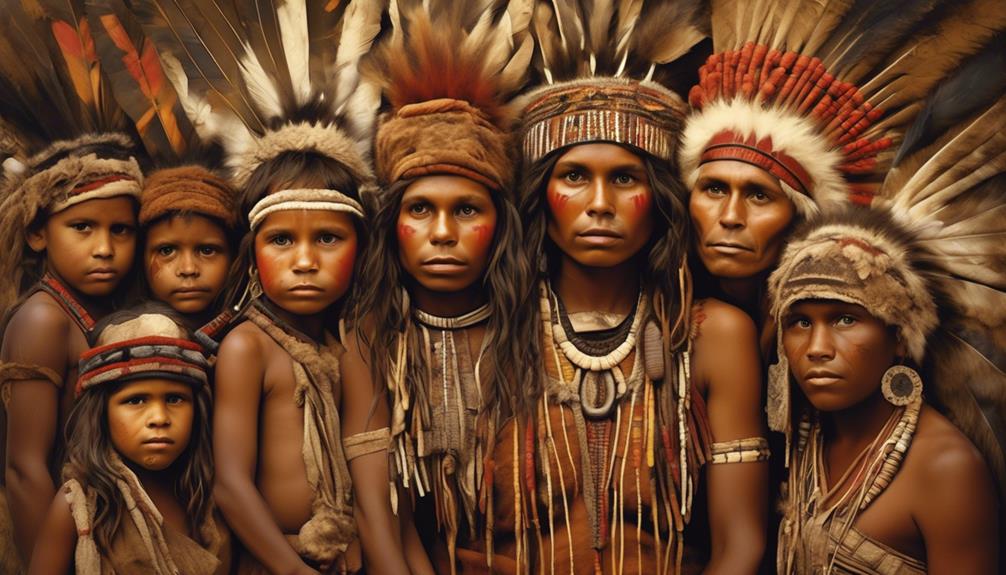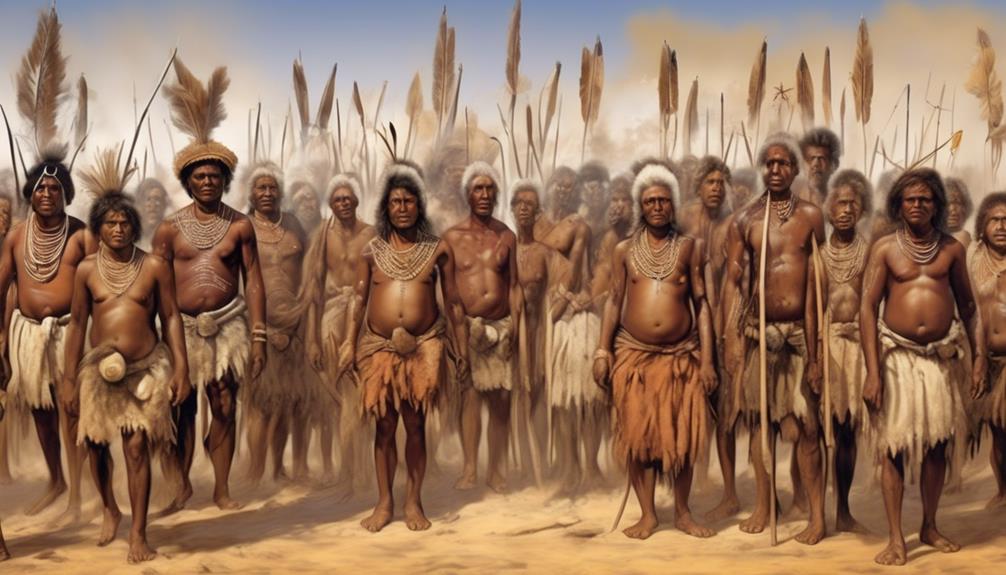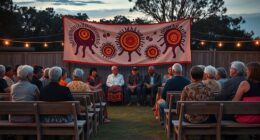When thinking about indigenous reservations, you may envision them as places teeming with rich cultural practices and close-knit communities. However, beyond that surface image, certain reservations face significant challenges, dealing with high levels of crime and a prevalent gang presence.
These reservations grapple with deep-rooted socioeconomic challenges, poverty, substance abuse, and mental health issues that contribute to their reputation as some of the most dangerous in the country.
But what factors contribute to this environment, and what are the communities doing to address these pressing concerns?
Key Takeaways
- High crime rates and gang activity are significant challenges on Native American reservations.
- Limited economic opportunities and unequal access to education contribute to socioeconomic challenges and poverty.
- Substance abuse and mental health issues are prevalent among Native American populations, and there are barriers to accessing treatment.
- Efforts towards community development, such as education initiatives and workforce development programs, are crucial for improving the well-being of Native American reservations.
Historical Context of Reservations
Throughout American history, Native reservations have played a crucial role in shaping the relationship between indigenous peoples and the U.S. government. The historical context of reservations is deeply intertwined with the concept of Native sovereignty and government policies.
The establishment of reservations began in the 19th century with the U.S. government's push to relocate Native American tribes from their ancestral lands to designated territories. This policy was rooted in the belief that confining indigenous peoples to specific areas would make it easier for the government to exert control over them. The reservation system, initially intended to isolate and assimilate Native Americans, ultimately led to the preservation of their distinct cultures and identities.
Government policies regarding reservations have evolved over time, reflecting changing attitudes and approaches towards Native sovereignty. The late 20th century saw a shift towards tribal self-determination, granting tribes greater autonomy in managing their affairs. However, challenges persist, including issues of economic development, social welfare, and jurisdictional conflicts.
Understanding the historical context of reservations is essential in comprehending the complex dynamics between indigenous communities and the U.S. government.
Crime Rates and Gang Activity

Crime rates and gang activity on Native reservations have been a persistent challenge, impacting the safety and well-being of the community members.
The following are key points to consider when examining this issue:
- Gang Violence: Gang-related activities have been a significant contributor to the crime rates on Native reservations, leading to heightened concerns about community safety and stability.
- Law Enforcement Strategies: Implementing effective law enforcement strategies has proven to be essential in addressing gang activity and reducing crime rates within Native reservations.
- Community Involvement: Engaging the local community in crime prevention efforts has shown promising results in mitigating gang violence and improving overall safety.
- Social and Economic Factors: Understanding the underlying social and economic factors that contribute to gang activity is crucial for developing targeted interventions and support systems.
- Preventive Measures: Proactive measures such as youth mentorship programs and access to education and employment opportunities play a vital role in deterring individuals from engaging in gang-related activities.
Socioeconomic Challenges and Poverty
The persistent challenges of crime rates and gang activity on Native reservations have been closely linked to the socioeconomic challenges and poverty experienced within these communities. Socioeconomic disparities and generational poverty have perpetuated a cycle of economic hardship, limited educational opportunities, and inadequate access to healthcare and social services. As a result, many Native American reservations face significant obstacles in breaking free from the cycle of poverty and improving their overall well-being.
| Socioeconomic Disparities | Generational Poverty |
|---|---|
| Limited economic opportunities | Inherited financial hardships |
| Unequal access to education | Lack of resources for future generations |
| Inadequate healthcare facilities | Limited access to healthcare services |
| Insufficient social services | Dependency on government assistance |
| High unemployment rates | Limited job prospects for future generations |
These challenges have contributed to the overall vulnerability of Native American communities, leaving them more susceptible to crime and gang activity. Addressing the root causes of socioeconomic disparities and generational poverty is crucial in creating a sustainable and positive change within these communities.
Substance Abuse and Mental Health Issues

Substance abuse and mental health issues are prevalent concerns affecting many Native American reservations, contributing to the complex challenges faced by these communities.
- High Prevalence: Substance abuse and mental health disorders are significantly more common among Native American populations compared to the general U.S. population.
- Barriers to Treatment: Limited access to addiction treatment and therapy options due to geographic isolation, lack of resources, and cultural stigmas present significant barriers to addressing these issues effectively.
- Historical Trauma: Historical injustices, such as forced assimilation and loss of cultural practices, have contributed to intergenerational trauma, which exacerbates substance abuse and mental health issues.
- Need for Culturally Tailored Interventions: Effective interventions require culturally competent approaches that incorporate traditional healing practices and community involvement to address the unique needs of Native American individuals and families.
- Integrated Care Models: Implementing integrated care models that address both substance abuse and mental health issues concurrently have shown promise in improving outcomes for Native American communities.
Understanding the complexities of substance abuse and mental health issues within Native American reservations is crucial for developing effective solutions and providing necessary support.
Efforts Toward Community Development
Efforts toward community development within Native American reservations are crucial for addressing the complex challenges that contribute to prevalent substance abuse and mental health issues. Historical trauma and limited access to treatment are significant factors that need to be addressed.
Education initiatives play a pivotal role in empowering individuals within these communities. By focusing on improving educational opportunities, including culturally relevant curricula and support services, reservations can foster a sense of purpose and hope for the future.
Additionally, workforce development programs are essential for creating sustainable economic opportunities, reducing unemployment rates, and breaking the cycle of poverty.
Infrastructure improvement is another vital aspect of community development. Access to reliable transportation, safe housing, and clean water is essential for the well-being of reservation residents.
Furthermore, enhancing healthcare access, including mental health services and addiction treatment facilities, is critical for addressing the pervasive health disparities within these communities.
Frequently Asked Questions
How Do Reservations Impact the Cultural Identity and Traditions of Native American Communities?
Reservations play a crucial role in preserving Native American cultural identity and traditions. They provide a space for traditional practices to thrive and serve as a hub for cultural preservation.
Through communal gatherings, ceremonies, and storytelling, reservations foster a strong sense of heritage and connection to ancestral traditions. These events and activities help to pass down knowledge and teachings from generation to generation, ensuring the continuity of Native American culture.
Despite challenges, such as limited resources and external pressures, reservations are vital for perpetuating indigenous culture and maintaining a sense of identity and belonging within Native American communities. They serve as a physical and symbolic reminder of the resilience and strength of Native American people, their history, and their ongoing commitment to their cultural heritage.
What Role Does the Federal Government Play in Addressing Crime and Gang Activity on Reservations?
The federal government's intervention on reservations is crucial in addressing crime and gang activity. Federal agencies provide resources, support law enforcement, and implement programs to combat these issues.
Additionally, community engagement is vital, as local input and collaboration are essential for sustainable solutions.
Federal intervention, combined with community involvement, can lead to effective strategies for reducing crime and gang activity on reservations.
How Do Socioeconomic Challenges on Reservations Compare to Those in Urban Areas?
Comparing socioeconomic challenges on reservations with those in urban areas reveals stark disparities. Education disparities, limited employment opportunities, poor healthcare access, and high poverty rates characterize reservation life.
These challenges contribute to the overall economic and social struggles faced by Native communities. Addressing these issues requires a comprehensive approach that considers the unique cultural and historical factors impacting reservations.
Understanding and addressing these disparities is essential for creating meaningful change.
What Specific Support and Resources Are Available for Addressing Substance Abuse and Mental Health Issues on Reservations?
For addressing substance abuse and mental health issues on reservations, specific support and resources include:
- Culturally sensitive counseling services
- Community development programs
- Traditional healing practices
These aim to address the unique challenges faced by Native communities, such as preserving cultural identity while tackling these issues.
Additionally, there are initiatives focused on improving access to healthcare and mental health support, recognizing the importance of holistic approaches in addressing these complex issues.
What Innovative Community Development Efforts Have Been Successful in Addressing the Unique Challenges Faced by Native American Reservations?
When it comes to addressing the unique challenges faced by Native American reservations, innovative community initiatives have been crucial. These initiatives often incorporate traditional practices and innovative programs to foster economic development.
By tapping into the rich cultural heritage and implementing forward-thinking strategies, these efforts have shown promise in creating sustainable change within Native American communities.
These initiatives offer a beacon of hope for addressing longstanding challenges and building a brighter future.
Conclusion
So, there you have it. The most dangerous native reservations.
But hey, who needs safety and security when you can have high crime rates, gang activity, poverty, substance abuse, and mental health issues, right?
Keep up the great work, reservations. Your communities are thriving!









